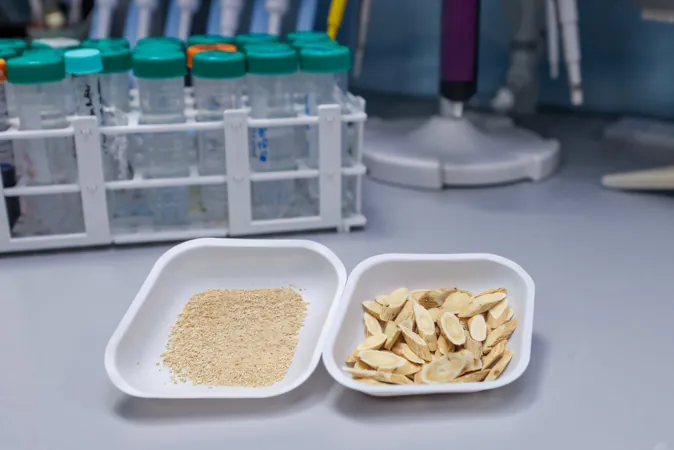
Breakthrough in Spinal Cord Injury Recovery: Vagus Nerve Stimulation Shows Promise
2025-06-12
Author: Arjun
Groundbreaking Clinical Study Unveils New Hope
In a revolutionary study from the Texas Biomedical Device Center at The University of Texas at Dallas, scientists have achieved remarkable recovery rates for individuals with spinal cord injuries. This research, featured in the esteemed journal Nature, reveals a cutting-edge treatment method that could redefine rehabilitation outcomes.
Transformative Therapy: Closed-Loop Vagus Nerve Stimulation (CLV)
The study introduced closed-loop vagus nerve stimulation (CLV), which combines nerve stimulation in the neck with personalized rehabilitation techniques. Participants, all suffering from incomplete spinal cord injuries, experienced significant improvements in their arm and hand functions thanks to this innovative approach.
Pivotal Next Steps for FDA Approval
Positioning itself for a critical clinical trial, the UT Dallas team aims to seek FDA approval for this groundbreaking treatment that targets upper-limb impairment following spinal cord injuries. This trial represents a culmination of over a decade of intensive research in neuroscience and bioengineering.
How It Works: The Science Behind CLV
The CLV therapy operates by sending electrical pulses to the brain via a small neck-implanted device, timed to coincide with rehabilitation exercises. This novel method has been shown to restore brain functions in patients post-stroke, and now it's showing promise for spinal cord injury patients—a world of difference for those previously facing bleak recovery prospects.
Real Impact: Participants Share Their Journey
Involving 19 participants aged between 21 to 65, the trial consisted of 12 weeks of rehabilitation where they engaged in interactive video games designed to promote upper-limb movements. The responsive device activated during successful movements, enhancing arm and hand strength significantly.
Exceptional Outcomes Unveiled by Researchers
Dr. Michael Kilgard, a leading neuroscientist on the project, pointed out that unlike stroke patients, who show improvement with therapy alone, spinal cord injury patients benefited drastically from the addition of CLV, producing gains in functionality they would not have achieved otherwise.
Broader Implications: A Gateway to New Therapies
The results are groundbreaking not just for the participants but for the tens of thousands of individuals living with spinal cord injuries, many of whom see few options for recovery. Dr. Jane Wigginton emphasized the significance of the outcomes, providing hope for a demographic that has long been neglected in treatment advancements.
What Lies Ahead: Phase 3 Trials and Beyond
Looking forward, a Phase 3 trial is in the pipeline, set to include 70 participants across various top U.S. institutions specializing in spinal cord injury research. There's an air of optimism, but also caution, as Dr. Seth Hays pointed out that the journey to making this therapy widely available is still fraught with challenges.
A Community of Dedication and Hope
The research team's journey is a testament to the relentless dedication of professionals and patients alike. Dr. Wigginton and her colleagues acknowledge the invaluable contributions of numerous partners, emphasizing the collaborative spirit that drives this pioneering work forward.
Conclusion: A Glimmer of Hope for the Future
The advent of CLV therapy marks a significant milestone in regenerative medicine, heralding new opportunities for individuals with spinal cord injuries. With continued research and collaboration, there’s hope for transformative advancements in rehabilitation—offering a better quality of life to those who need it most.


 Brasil (PT)
Brasil (PT)
 Canada (EN)
Canada (EN)
 Chile (ES)
Chile (ES)
 Česko (CS)
Česko (CS)
 대한민국 (KO)
대한민국 (KO)
 España (ES)
España (ES)
 France (FR)
France (FR)
 Hong Kong (EN)
Hong Kong (EN)
 Italia (IT)
Italia (IT)
 日本 (JA)
日本 (JA)
 Magyarország (HU)
Magyarország (HU)
 Norge (NO)
Norge (NO)
 Polska (PL)
Polska (PL)
 Schweiz (DE)
Schweiz (DE)
 Singapore (EN)
Singapore (EN)
 Sverige (SV)
Sverige (SV)
 Suomi (FI)
Suomi (FI)
 Türkiye (TR)
Türkiye (TR)
 الإمارات العربية المتحدة (AR)
الإمارات العربية المتحدة (AR)